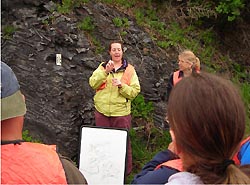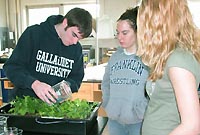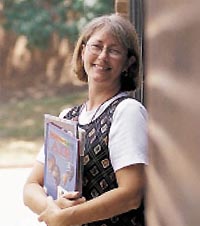Educator Features
Signs of Science
07.27.06
| Who Are NASA's Earth Explorers? The elementary school student questioning if El Niño occurs anywhere besides the Pacific Ocean. The researcher investigating connections between Arctic ozone depletion and global climate change. The citizen scientist interested in how changing land cover and use affects animal migration patterns. And the businessperson projecting future needs for harvest, delivery and storage of crops. All of these people are Earth Explorers -- they are all connected by their curiosity about Earth system processes. This monthly series will introduce you to NASA Earth Explorers, young and old, with a variety of backgrounds and interests. Nominate an Earth Explorer! Tell us about the Earth Explorers you know. We're looking for students, teachers, scientists and others who are working with NASA Earth science data and imagery to better understand our home planet. Send your nominations to Dan Stillman: dan_stillman@strategies.org. |

|
Image to right: University of Massachusetts Amherst geologist Michele Cooke uses sign language to describe how tectonic forces deformed and folded rocks along a Massachusetts highway. Credit: Mary Ellsworth
Several such high school students got an up close look at these and other geological phenomena during a recent five-day field study in Massachusetts. Their teachers, Mary Ellsworth and Teresa Huckleberry, know the importance of visual and hands-on methods in explaining science without benefit of the spoken word.

|
Image to left: Teresa Huckleberry teaches at the Indiana School for the Deaf. Credit: Teresa Huckleberry
Huckleberry, an Earth system science teacher at the Indiana School for the Deaf in Indianapolis, echoes a similar sentiment.
"It is important that students learn to do science, not just read about it in a book," said Huckleberry, who won Indiana's 1994 Christa McAuliffe Fellowship and used the grant money to establish an aviation training program for her students.
Every year, in the spirit of "doing" science, Huckleberry teams her deaf students with hearing students from a nearby school for a weeklong visit to NASA's Kennedy Space Center. As part of the trip, the students go scuba diving off Key Largo, Fla., to simulate the microgravity of space. They also meet NASA divers, who explain how they retrieve the solid rocket boosters that splash down into the Atlantic Ocean after powering the space shuttle off the launch pad.
| Related Resources + Deaf Women and Men in Science + GLOBE + Captioned NASA Videos for the Hearing Impaired + Previous Earth Explorers Articles |
Both, for example, have their students participate in the Global Learning and Observations to Benefit the Environment Project, which NASA and the National Science Foundation sponsor. Students taking part in GLOBE make measurements of the atmosphere, land, water, and plant and animal life. They then submit their observations to the GLOBE Web site for use by students and scientists around the world.
"Two of the most important science process skills that all students must learn are measuring and communicating," Huckleberry said. "Doing the GLOBE measurements and communicating the results via [the Internet] helps students learn process skills of doing science in a very visual way."
Huckleberry also uses a plant growth chamber that was developed by a private corporation with funding from NASA. Students grow lettuce and miniature tomatoes in the chamber, which models how to grow plants efficiently in space.
 |
Field trips and hands-on projects aside, teachers sometimes have to rely on traditional classroom instruction to communicate scientific concepts, which in the case of Ellsworth and Huckleberry means giving lectures in sign language. It turns out that sign language lends itself quite well to explaining Earth science concepts, many of which require three-dimensional visualization.
"Sign language makes use of three-dimensional space in a different way than verbal language does," said Ellsworth, a 2003 winner of the Presidential Awards for Excellence in Math and Science Teaching. "Deaf students may be particularly adept at using this visual information."
Technology is another critical learning tool. Ellsworth developed "SOAR-High Earth System Science," a Web site that facilitates collaborative study of the Earth among students and teachers from six schools, four of which cater primarily to deaf students. The site contains four units of Earth system science coursework. It also allows students to share pictures and data, engages them in online discussions, provides information about videoconferencing, and links to various Earth science education resources.

|
Ellsworth also maintains the "Deaf Women and Men in Science" Web site, which profiles accomplished hard-of-hearing scientists of the past and present. Students are encouraged to learn and write reports about the featured scientists, and can search a database of deaf science professionals.
While Ellsworth and Huckleberry consider role models and creative approaches important to their teaching success, both are quick to point out that, in many ways, the challenges of communicating science are the same, whether a student can or cannot hear.
"Most of the challenges I have in teaching Earth system science with deaf and hard-of-hearing students are no different than the challenges of teaching hearing students," Huckleberry said. "My students are normal teenagers with normal growing pains."